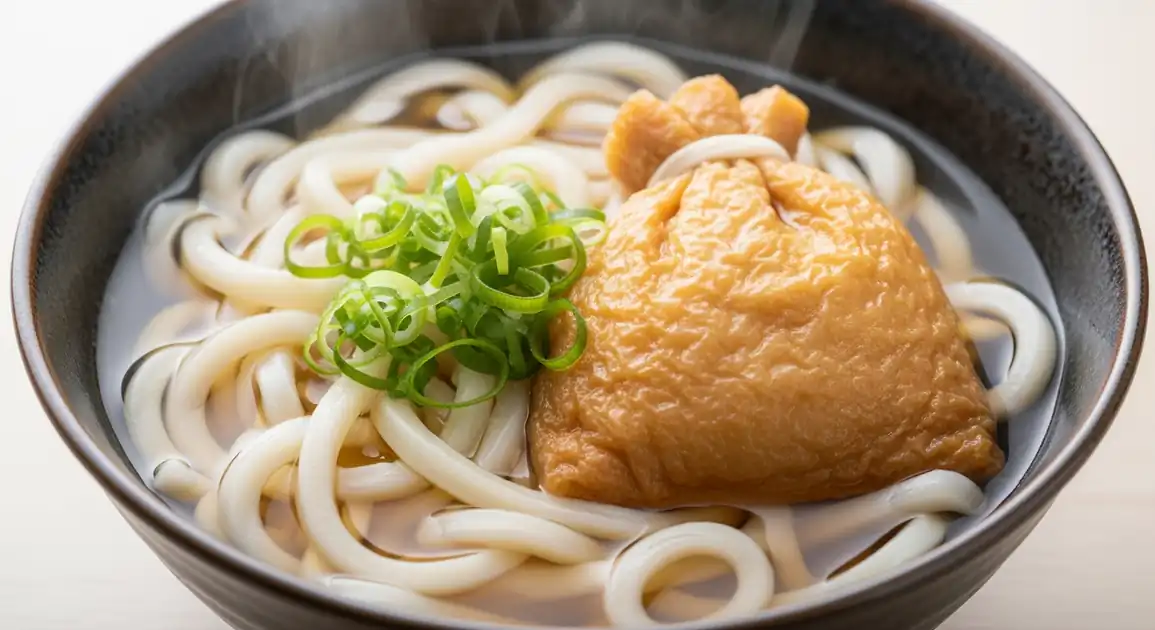Kitsune Udon (Sweet Fried Tofu Udon)
きつねうどん

Description
Udon is a staple noodle dish across Japan, enjoyed hot or cold. Kitsune Udon is one of the most classic and widely available hot udon varieties, found in specialty shops, train stations, and casual eateries nationwide. Quality and regional broth styles (Kansai vs Kanto) can vary.
Dietary Information
Serving information
Serving style
Served hot in a deep ceramic bowl ('donburi'). Eaten with chopsticks. A large spoon ('renge') may be provided for the broth. Condiments like shichimi togarashi are often available on the table.
Quick facts
Lunch focused (11 AM - 3 PM), many also open for dinner (5 PM - 9 PM). Station shops may open earlier/later.
Safety Tips
What to Look For
-
Steaming hot broth
Ensures the dish is freshly prepared and served at a safe temperature, killing potential bacteria.
-
Clean restaurant environment
Clean tables, counters, condiment containers, and staff hygiene are good indicators of overall food safety practices.
-
Freshly cooked noodles (if visible)
Noodles should be springy, not mushy or broken, indicating they haven't been sitting too long.
-
Plump, intact aburaage
The tofu topping should look appetizing and well-prepared, not dried out or falling apart.
-
High customer turnover
Busy restaurants generally use fresher ingredients and maintain higher standards.
What to avoid
-
Lukewarm broth or noodles
Food served at improper temperatures can harbor bacteria. Insist on hot food.
-
Dirty tables, utensils, or condiment containers
Poor cleanliness increases the risk of contamination.
-
Off-smells from the kitchen or dining area
Unpleasant odors can indicate poor sanitation or spoiled ingredients.
-
Wilted or old-looking garnishes (scallions)
Suggests lack of attention to freshness and detail.
Price information
Price range
Budget tips
- Standing udon counters ('tachigui udon') and train station shops offer the lowest prices.
- Basic udon shops ('udon-ya') are generally affordable.
- Prices increase in department stores or full-service restaurants with more elaborate settings.
Value indicators
- Clear, flavorful dashi broth.
- Properly cooked, chewy udon noodles.
- Large, juicy, well-seasoned aburaage.
- Fresh garnishes.
Where to Find This Dish
Near Train Stations
High concentration of quick-service udon/soba shops.
Major stations like Tokyo Station, Shinjuku Station, Osaka Station
Commuting hours, Lunch
Shopping Arcades ('Shotengai')
Local shopping streets often have long-standing udon restaurants.
Various local shotengai across cities
Lunch, Early Dinner
Department Store Restaurant Floors ('Depachika')
Offer convenient dining options, often including udon.
Takashimaya, Mitsukoshi, Isetan etc.
Lunch, Dinner
Vendor Tips
- Look for shops making noodles in-house ('teuchi udon') for superior texture.
- Ticket machines ('kenbaiki') are common for ordering in quick-service shops.
- Observe the dashi color - lighter often indicates Kansai style, darker suggests Kanto style.
How to Order
Regional Variations
-
Tanuki Udon
(たぬきうどん)
Udon soup topped with tenkasu (crunchy tempura batter bits) instead of aburaage.
-
Tempura Udon
(天ぷらうどん)
Udon soup served with assorted tempura (deep-fried seafood and vegetables) on top or on the side.
-
Niku Udon
(肉うどん)
Udon soup topped with thinly sliced beef simmered in a sweet and savory sauce.
-
Curry Udon
(カレーうどん)
Udon noodles served in a thick, Japanese-style curry sauce instead of dashi broth.
-
Kansai vs Kanto Style Broth
(関西風・関東風だし)
Kansai (Osaka region) style dashi is typically lighter in color and flavor, relying more on kombu. Kanto (Tokyo region) style often uses more dark soy sauce and bonito, resulting in a darker, stronger flavor. Kitsune Udon often features the lighter Kansai style.
Cultural context
History
Kitsune Udon is widely believed to have originated in Osaka during the late Meiji or early Taisho period (late 19th/early 20th century). The restaurant Usami-tei Matsubaya in Osaka is often credited with its creation. The name 'Kitsune' (fox) stems from Japanese folklore associating foxes with a love for aburaage. It quickly became a popular and affordable dish, especially cherished in the Kansai region (including Osaka).
Local significance
Udon is a fundamental part of Japanese cuisine, representing comfort food and regional diversity. Kitsune Udon is a widely recognized classic.
Eating customs
- Use chopsticks for noodles and toppings.
- Drink broth directly from the bowl or use a provided spoon.
- Add condiments like shichimi togarashi to taste.